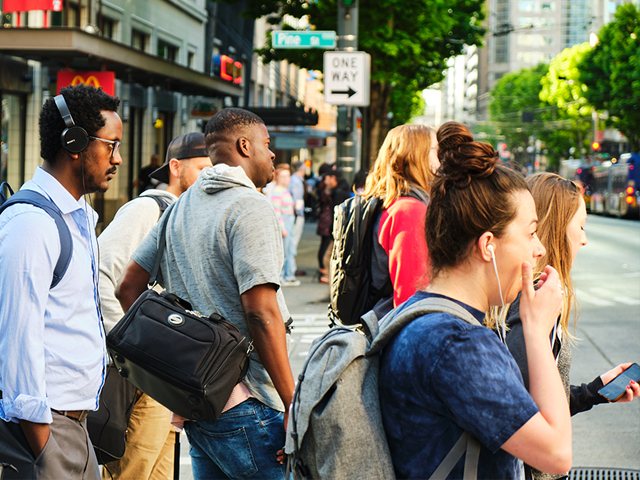News
The Seattle Times: Redesigning Third Avenue right will ensure a connected, revived downtown
Posted on

This story was originally published by The Seattle Times on Oct. 7, 2022.
The Seattle City Council has set about a leisurely journey to “re-imagine” Third Avenue, the main transit corridor in the city. In addition to “walls of buses,” the street is a magnet for crime and illegal drugs.
As a Third Avenue resident, I’d say the council needs a bias for action and not only for my convenience and safety. The economic engine of the city, downtown, depends on it. The center city generates most of Seattle’s business taxes, and we’re already facing a budget shortfall.
The city’s future is unclear as we move from pandemic to watchful waiting on COVID-19. Ensuring the best shot for Seattle depends on saving Third Avenue.
The street’s true character is complicated.
I’ve come back and forth along Third for years without even witnessing a major crime. I don’t feel unsafe. Buses are frequent and get jammed up at stations, but other times the street is almost tranquil.
True, Third had a deservedly bad reputation for years, especially around Pine and Pike, and south toward the courthouse. I’ve written before about hearing gunshots in the night and seeing smashed windows, as well as shootings amid rising violent crime.
But in the “Before Times” (before out-of-control shoplifting, COVID and the civil unrest following the murder of George Floyd by a Minneapolis police officer), the street was rich with commerce, where office workers, shoppers and tourists outnumbered troublemakers.
Back then, Third Avenue hosted Bed Bath & Beyond, Bergman Luggage, Macy’s, Columbia Sportswear, IGA Kress and so many other useful and destination stores. All are gone, with blocks of boarded-up space and people getting fixes on the sidewalk.
Benaroya Hall, the acclaimed concert hall built for the ages, faces Third. The Seattle Symphony still plays there, thank goodness. But the street’s reputation and reality require security guards patrolling the sidewalk (I wonder how much money businesses and organizations must spend on private security now, thanks to the City Council majority’s hostility to the Seattle Police Department?).
Across the street, the Wild Ginger restaurant has planted its flag, despite frequent smashing of windows by vandals. How much is spent every month replacing plate glass all over downtown? A new $2 million city storefront repair fund will help but one can only imagine the rising insurance premiums these smashed businesses face.
Yet a wonderful dinner, inspiring concert and safe walk home to Belltown were experienced this past Saturday night.
Which brings me back to the importance of getting a re-imagined Third Avenue right.
It remains unclear how much remote work will affect downtown.
The offices may not be mostly empty forever. In August, 44% of workers had returned to downtown offices in remote-friendly Seattle compared with the eve of the pandemic. It was the highest level of workers in offices yet.
Also, a survey found a rift nationally between those working remotely and others from the office over pay and job security. For example, most respondents said working permanently from home will harm their career prospects.
But urban scholar Richard Florida has pretty much pronounced the office-heavy central business district dead in many cities (some exceptions include Austin, Houston and Dallas).
In its place can be “central connectivity districts.” In an article for Bloomberg CityLab in August, Florida wrote, “The rise of remote work today won’t kill off our downtowns, but they will be forced to change once again. And with smart strategies and perseverance on the part of city leaders, real estate developers and the civic community, they can become even better than they were.”
Many people still want to live in downtowns. Nearly 99,000 people lived in Seattle’s central city in 2021, a 67% increase since 2010, according to the Downtown Seattle Association.
Of the central connectivity district, Florida wrote, “But downtowns today are not just places to live, work and shop: They are the very best places for people and businesses to connect to each other.
“In big metros and small, downtowns occupy the most central locations and have the highest concentrations of spaces where people can come together. Even where offices remain relatively empty, downtown neighborhoods are abuzz with all manner of social activity. Restaurant reservations are at 98% of their pre-COVID levels; attendance at arts, theater, and cultural venues has similarly rebounded; and basketball and hockey arenas are full.”
This pretty much describes Seattle, without the NBA. And Third Avenue is the lifeblood of making it all work. Or not.
In recent months, I’ve seen Third’s problems spread to Fourth Avenue, where a walk of a few blocks reveals people using drugs huddled against buildings. Fourth was once one of the safest, most beautiful streets downtown.
Wider sidewalks are a no-brainer to improve Third Avenue. As for how buses are routed, I’m agnostic. In the “Before Times,” the buses didn’t interfere with the vibrancy of the street. They arguably enhanced it (although some shuttered businesses cited lost parking spaces in front).
Benaroya Hall and Wild Ginger are central to cultural connectivity; farther south one can reach the sports stadiums.
But two elements are essential to success.
First is a program to incentivize the revival of shops along Third — the Mattress Firm in the Securities Firm building has been hanging on but blocks south of there is almost an entirely boarded-up wasteland that three years ago were packed with stores and restaurants.
Second is public safety. No redesigned Third Avenue will work unless people feel safe. Connectivity fails when crime prevails.
Jon Talton: jtalton@seattletimes.com; on Twitter: @jontalton. Talton writes about business and the Pacific Northwest economy in the Sunday Seattle Times.